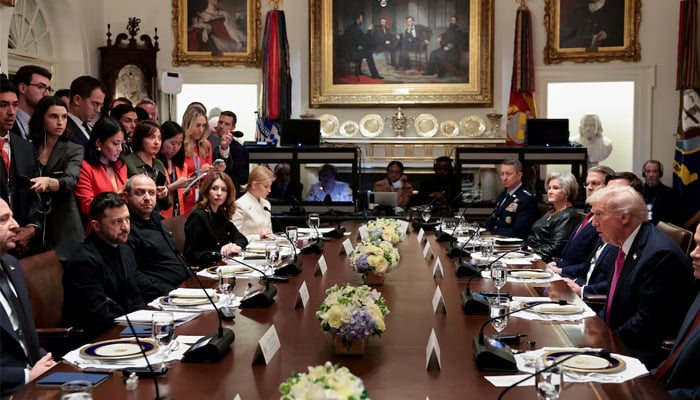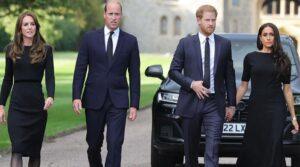
- Zelenskiy’s visit was aimed at acquiring weapons to maintain the war with Russia.
- Trump seems more determined to negotiate a peace agreement between two parties.
- The presidents of the United States and Ukraine discuss the call between Russia’s Putin and Trump.
Ukrainian President Volodymyr Zelenskiy arrived at the White House on Friday seeking weapons to continue waging his country’s war against Russia, but met with an American president who appears more intent on negotiating a peace deal than upgrading Ukraine’s arsenal.
While US President Donald Trump did not rule out providing the long-range Tomahawk missiles Zelenskiy is seeking, Trump appeared calm about the prospect as he looked forward to a meeting with Russian President Vladimir Putin in Hungary in the coming weeks.
The two leaders then met behind closed doors, where they also discussed a call from the previous day between the Russian president and Trump, who has presented himself as a mediator between the warring forces despite Russia’s invasion of Ukraine in 2022.
‘Get along for a bit’
“I think President Zelenskiy wants it done, and I think President Putin wants it done. Now all they have to do is get along a little bit,” Trump told reporters.
Zelenskiy, however, highlighted how difficult it has been to try to achieve a ceasefire. “We want this. Putin doesn’t want it,” he said.
The Ukrainian leader was blunt, telling Trump that Ukraine has thousands of drones ready for an offensive against Russian targets, but needs American missiles.
“We don’t have Tomahawks, that’s why we need them,” he said.
Trump responded: “We’d rather they didn’t need Tomahawks.”
Trump later reiterated that he wants the United States to keep its weapons. “We also want Tomahawks. We don’t want to give away things that we need to protect our country,” he said.
After the meeting, which Zelenskiy described as productive, he told reporters he did not want to talk about long-range missiles, saying the United States did not want an escalation and was “realistic” about its chances of getting them.
The Ukrainian president, who spoke by phone with European leaders after the meeting, said he was counting on Trump to pressure Putin “to stop this war.”
When asked about Trump’s comments, Zelenskiy said: “The president (Trump) is right and we have to stop where we are. This is important, to stop where we are and then talk.”
back to the table
It was unclear what Putin had told Trump that prompted him to agree to the upcoming meeting. Their August summit in Alaska ended early without much progress.
The Kremlin said much needed to be decided and the summit could take place “a little later” than within the two-week period mentioned by Trump.
Trump’s conciliatory tone after the call with Putin raised doubts about the near-term likelihood of assistance to Ukraine and revived European fears of a deal that suits Russia. A European Union spokesman said it welcomed talks if they could help bring peace to Ukraine.
Trump was asked on Friday if he was concerned that Putin might be “buying time” with him by agreeing to talks.
“You know, my whole life I’ve been played by the best and turned out very well, so it’s possible,” Trump responded.
Michael Carpenter, a former U.S. official who is now a senior fellow at the International Institute for Strategic Studies, said the meeting with Trump was not what Zelenskiy had hoped for, but was in line with the administration’s approach to the war.
“The underlying reality is that there is no inclination to impose costs on Russia,” he said.
The president expressed affection for Zelenskiy, at one point praising him for wearing what Trump called a “very stylish” dark suit jacket after he was beaten earlier this year for visiting the White House without it.
“He looks beautiful in his jacket,” Trump said. “I hope people notice.”
The war has escalated
Trump, who has campaigned for the Nobel Peace Prize, is eager to add to the list of conflicts he says he has been instrumental in ending.
More than three and a half years after its full-scale invasion of Ukraine, Russia has made some territorial gains this year, but Ukraine’s top military commander, Oleksandr Syrskyi, said Thursday that the Russian offensive had failed.
Putin said this month that his forces had seized nearly 5,000 square kilometers (1,930 square miles) of land in Ukraine by 2025, equivalent to adding 1% of Ukraine’s territory to the nearly 20% it already occupies.
Both sides have also stepped up attacks on each other’s energy systems, and Russian drones and aircraft have been diverted toward NATO countries.
Analysts see the talks as a delaying tactic
In recent days, the White House appeared to be increasingly frustrated with Putin and leaning toward giving Zelenskiy new support, including Tomahawk missiles that the Ukrainians said would help them inflict more damage on the Russian war machine.
After Friday’s talks, Zelenskiy said Russia was “afraid” of the Tomahawks. Moscow has warned that the supply of such missiles would mark a serious escalation.
Putin’s move seemed intended to make a U.S. transfer of such weapons less likely, said Max Bergmann, a Russia expert at the Center for Strategic and International Studies.
Mykola Bielieskov, a senior analyst at Come Back Alive, a Ukrainian non-governmental organization that is a major buyer of military equipment for the Ukrainian armed forces, said the Tomahawk missiles would level the playing field that is tilted toward Russia.
“We do not expect Russia to crumble after one, two or three successful attacks,” Bielieskov said. “But it’s about pressure, constant pressure. It’s about disrupting the military-industrial complex.”



